
Cephalissa is a monotypic moth genus in the family Geometridae. Its only species, Cephalissa siria, the orange triangle moth, is endemic to New Zealand. This species has been classified as nationally vulnerable by the Department of Conservation. It has suffered a contraction of its range, no longer being seen in Dunedin or Invercargill. It is currently found in the Mt Watkin Scenic Reserve, in eastern Otago, in the Rongahere Gorge and in the Dansey Ecological District. C. siria is known to inhabit kahikatea forest amongst Carex species as well as short tussock grasslands and shrubland. The larval host plant is Fuchsia perscandens. Adult moths are on the wing in October and November.

Bascantis is a genus of moths belonging to the family Tineidae. It contains only one species, Bascantis sirenica, that is endemic to New Zealand. This species is classified as "Data Deficient" by the Department of Conservation.

Acrocercops leucocyma, also known as the kauri leafminer, is a species of moth in the family Gracillariidae. It is endemic to New Zealand.

Izatha caustopa is a lichen tuft moth in the family Oecophoridae. It is endemic to New Zealand, where it is known very locally, and very infrequently, from the southern half of the North Island: two specimens collected in 2016 were the first seen for 30 years. It is classified as "Data Deficient" by the Department of Conservation.

Batrachedra eucola is a species of moth in the family Batrachedridae. It is endemic to New Zealand and found both the North and South Islands. This species frequents scrubland habitat and is on the wing in January and February. B. eucola can be easily distinguished from its close relatives as it larger in size, has a pronounced palpi tuft and has full neuration of its hindwings.

Batrachedra psithyra, the spleenwort spore-eater, is a species of moth of the family Batrachedridae. It is endemic to New Zealand. This species has been observed in the North, South and Matiu / Somes Islands. This species inhabits overgrown grasslands or fern glades and have also been observed in gumland heath. The larvae of this species feed on fern sori including those on Histiopteris incisa. Adults are on the wing from November to January and tends to fly at sunset. At rest this species raises the front part of its body and when moving waves alternate antennae.
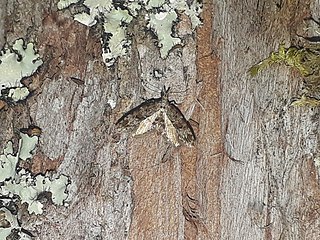
Isonomeutis restincta, the marbled snouter, is a species of moth in the family Copromorphidae. It is endemic to New Zealand where it is likely found in the northern parts of the North Island. Not much is known of the life history of this species but it has been hypothesised that it is a scale insect predator. The adults of this species are on the wing from November to January. This species has been classified as "At Risk, Naturally Uncommon" by the Department of Conservation.
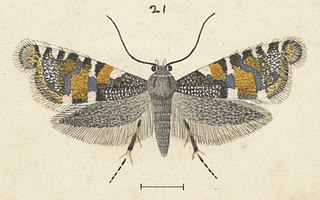
Glyphipterix euastera is a species of sedge moth in the genus Glyphipterix. It is endemic to New Zealand. This species is classified as "At Risk, Naturally Uncommon" by the Department of Conservation.

Chersadaula ochrogastra is a species of moth in the family Oecophoridae. This species is endemic to New Zealand. It is classified as "Data Deficient" by the Department of Conservation.

Stathmopoda campylocha is a species of moth in the family Stathmopodidae. It is endemic to New Zealand. It is classified as critically endangered by the Department of Conservation.
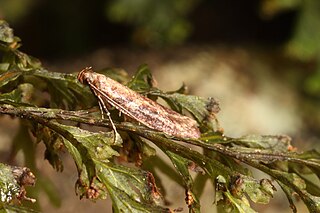
Cadmogenes is a genus of moths of the family Plutellidae. It contains only one species, Cadmogenes literata, which is found in New Zealand. This species is endemic to New Zealand. It has been classified as "Not Threatened" by the Department of Conservation.
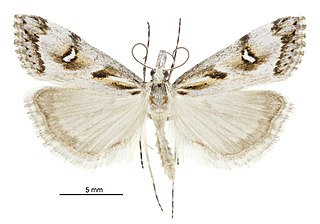
Gadira leucophthalma, the beaked moss moth, is a moth in the family Crambidae. It is endemic to New Zealand. It is found in the south eastern side of the South Island down to Banks Peninsula. G. leucophthalma inhabits the foredunes of coastal areas. The larval host is unknown but it has been hypothesised that the larvae feed on moss. The adult moths are day flying although some specimens have been trapped at night via light traps. Adults are commonly on the wing from March to April. This species has been classified as Nationally Vulnerable by the Department of Conservation.

Pyrgotis transfixa is a species of moth of the family Tortricidae. It is endemic to New Zealand. It is classified as "At Risk, Naturally Uncommon" by the Department of Conservation.

Hierodoris stella is a species of moth in the family Oecophoridae. This species is endemic to New Zealand and occurs in Auckland, Taranaki, Hawkes Bay, Bay of Plenty and Wellington. As at 2005 the larvae of this species is unknown as is its host plant. The adult moth frequents forest and are on the wing in January and February. It is classified as "At Risk, Relict'" by the Department of Conservation.

Tingena loxotis is a species of moth in the family Oecophoridae. This species is endemic to New Zealand and is found in the North Island. This species is found in gardens and are known to enter houses. Adults are on the wing in December and January. It is classified as "Data Deficient" by the Department of Conservation.

Notoreas atmogramma is a species of moth in the family Geometridae. This species is endemic to New Zealand. It is a day flying moth that frequents alpine habitat.

Notoreas ischnocyma is a species of moth in the family Geometridae. This species is endemic to New Zealand. This species is found in Canterbury and Otago.
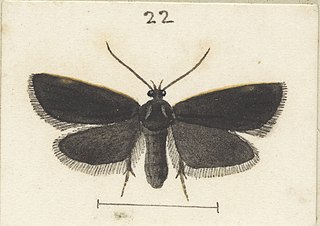
Cryptolechia semnodes is a moth in the family Depressariidae. It is endemic to New Zealand. It was first described by Edward Meyrick in 1911 using a specimen collected at Mount Arthur tableland in February. It is dark in appearance and likely belongs to another genus. This species flies in bright sunshine and is likely a very local species. It is likely that this species probably belongs to another genus and as such this species is also known as Cryptolechia (s.l.) semnodes.
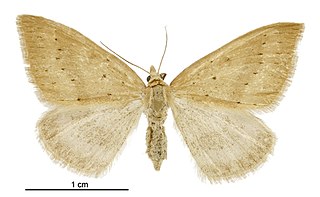
Asaphodes mnesichola is a species of moth in the family Geometridae. It is endemic to New Zealand and has been observed in the South Island. This species inhabits subalpine native scrub. Adults of this species are on the wing in January and February.
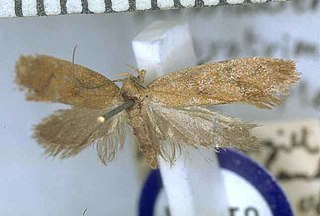
Tingena paratrimma is a species of moth in the family Oecophoridae. It is endemic to New Zealand and has been observed in the lower parts of the South Island. George Hudson regarded this species are uncommon. The adults of this species are on the wing from November to February.





















